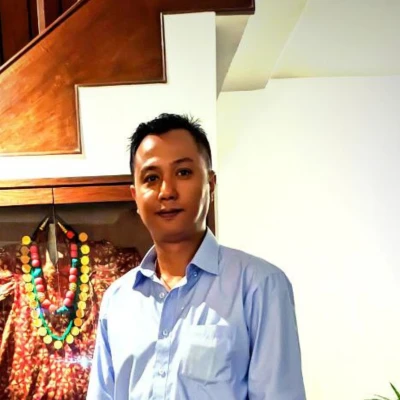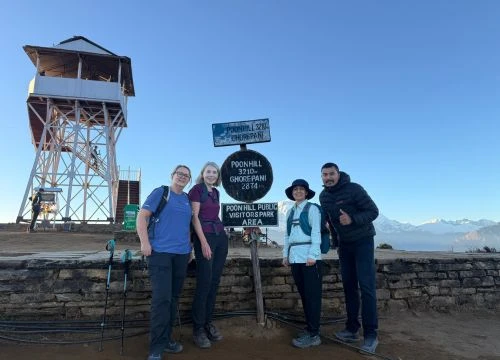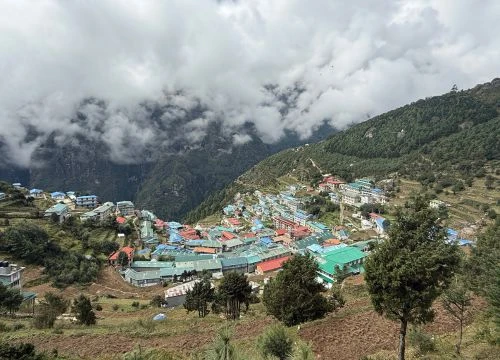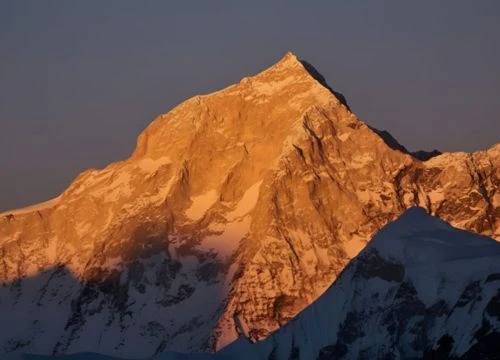About Mount Cho Oyu
Cho Oyu means "Turquoise Goddess" in Tibetan, a reference to the stunning glacial lakes that reflect the mountain's imposing bulk.
Mt. Cho Oyu lies approximately 20 kilometres west of Mount Everest, where this massive pyramid of rock and ice dominates the skyline along the Tibet-Nepal border.
At 8,188 metres (26,864 feet), Mount Cho Oyu is the sixth-highest mountain in the world.
The first ascent came on 19 October 1954, when Austrian expedition leader Herbert Tichy led a small team up what is now known as the standard northwest ridge route.
Their achievement marked the fourth of the fourteen 8,000-metre peaks to be climbed, following Annapurna, Everest, and Nanga Parbat.
Cho Oyu was the fifth peak in the world to be first climbed among the 8,000-meter peaks, and the Austrian expedition chose the northwest ridge after careful reconnaissance.
The mountain's significance extends beyond its impressive height as the 6th highest mountain on earth.
Mt. Cho Oyu serves as a crucial training ground for climbers aspiring to tackle more technically demanding peaks like Everest or K2.
Why Choose Mount Cho Oyu
For climbers considering their first 8,000-metre peak, Mount Cho Oyu presents several compelling advantages:
The northwest ridge offers a logical line up relatively moderate terrain
Less technical climbing compared to Everest's Khumbu Glacier/Icefall challenges
Shorter exposure to the extreme altitude environment
Well-established expedition infrastructure from decades of climbing
Higher chance of success compared to more technical peaks
Comparison with Other 8,000-Metre Peaks
Peak | Difficulty Level | Technical Sections | Success Rate | Best for First-Timers |
Cho Oyu | Moderate | Minimal | 60-75% | Excellent |
Everest | High | Khumbu Icefall, Hillary Step | 30-60% | Not recommended |
Manaslu | High | Avalanche zones, technical ice | 30-50% | Challenging |
Lhotse | Moderate | Glacial slopes, snow ridges | 35-55% | Unlikely |
Kanchenjunga | High | Seracs, steep slopes, avalanches | 50-75% | Possible |
When compared to Mount Everest, the differences become immediately apparent. Specifically, an Everest expedition demands navigation through the treacherous Khumbu Icefall, requires extensive experience with fixed ropes and jumars, and subjects climbers to the notorious "death zone" for extended periods. In contrast, a Mt. Cho Oyu expedition offers a more straightforward ascent with shorter exposure to extreme altitude.
Similarly, peaks like Manaslu present objective hazards that make them unsuitable for novice high-altitude climbers. Additionally, Manaslu's reputation for avalanche danger contrasts sharply with Mount Cho Oyu's more forgiving character. Furthermore, the mountain's unique position also provides remarkable views throughout the climb, offering spectacular panoramas of Everest, Lhotse, and the entire Himalayan chain stretching into the distance.
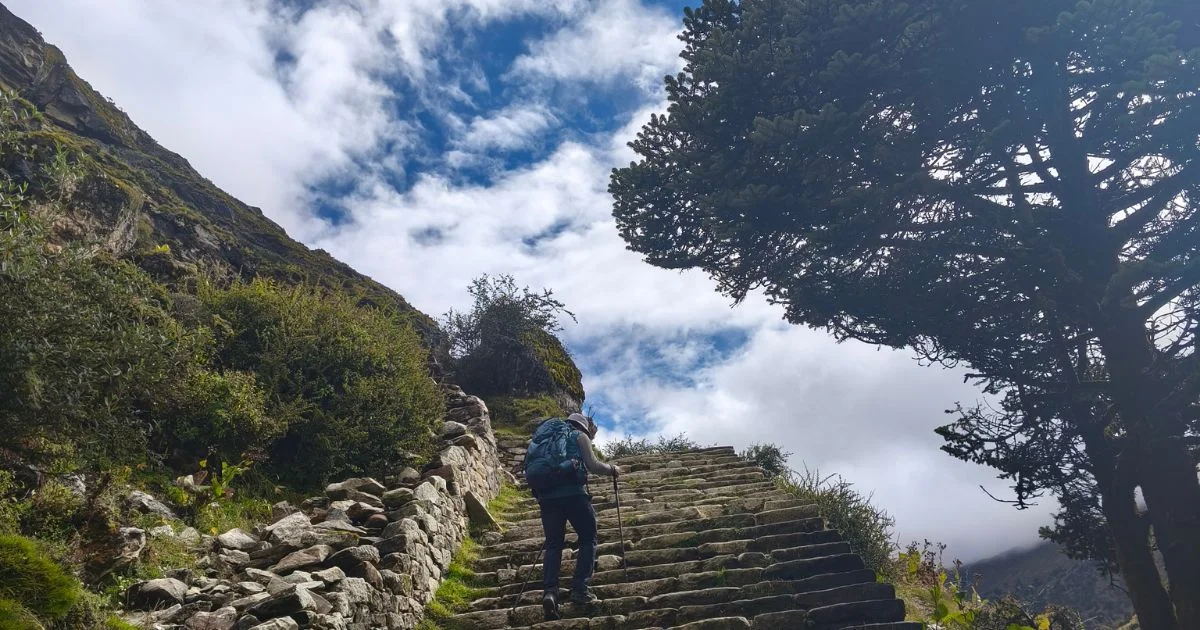
Routes to the Summit
The standard route up Cho Oyu follows the northwest ridge route from the Tibetan side, a path that has remained largely unchanged since the first ascent in 1954. Moreover, this route typically establishes three camps above base camp, creating a logical progression that allows for proper acclimatisation.
Initially, base camp sits at approximately 5,700 metres on the Rongbuk Glacier's west branch. Subsequently, the initial approach involves a gradual walk across relatively flat glacier terrain, allowing climbers to adapt to the altitude while covering the ground toward Advanced Base Camp at 6,400 metres.
Camp Progression on Cho Oyu:
Base Camp (5,700m) - Equipment staging and initial acclimatisation
Advanced Base Camp (6,400m) - Main expedition base with extended stays
Camp I (7,000m) - First high camp requiring technical skills
Camp II (7,500m) - Summit staging camp on broad plateau
Summit (8,188m) - Final push via the northwest ridge
Nevertheless, Camp I, positioned at roughly 7,000 metres, requires crossing some crevassed sections but generally follows obvious terrain up the broad northwest ridge. Additionally, the route between Advanced Base Camp and Camp I includes the technical crux of the climb: a steep slope that may require fixed ropes during busy seasons.
Meanwhile, Camp II, established around 7,500 metres, sits on a broad summit plateau offering some protection from the prevailing winds. Consequently, this camp serves as the final staging point before the summit push, with most expeditions making their bid from here rather than establishing a higher camp.
Finally, the summit route from Camp II follows the ridge line directly toward the top, passing through terrain that becomes increasingly exposed but remains technically straightforward. However, the final 300 metres require sustained effort in thin air, though the slope rarely exceeds 45 degrees.
Permits, Visas and Regulations
Climbing Cho Oyu requires careful attention to bureaucratic requirements, particularly for the standard Tibet-side route. Therefore, the Chinese Tibet Mountaineering Association (CTMA) issues climbing permits, which must be arranged through authorized agencies based in Tibet or China.
Essential Permit Requirements:
Chinese visa with Tibet Travel Permit
CTMA climbing permit ($2,500 per person)
Environmental protection deposit
Liaison officer assignment and fees
Comprehensive mountaineering insurance coverage
Initially, the permit process begins with obtaining a Chinese visa, which requires submission of documents including a valid passport, completed application forms, and proof of arranged accommodation in Tibet. Furthermore, climbers cannot apply for Tibet permits independently and must work through registered expedition companies or agents.
Moreover, all expeditions require the presence of a qualified liaison officer, whose fees and expenses form part of the overall expedition cost. Subsequently, these officials serve as the link between climbing teams and Chinese authorities, ensuring compliance with regulations and safety protocols on the Tibetan plateau.
Additionally, this expedition on Cho Oyu requires approximately 8-12 weeks for complete permit processing, making early planning essential for any peak to climb of this magnitude.
Best Time to Climb Mount Cho Oyu
Cho Oyu offers two distinct climbing seasons, each with particular advantages depending on experience level and personal preferences. Therefore, spring and autumn provide the most reliable weather windows for expeditions to Cho Oyu, though conditions can vary significantly from year to year.
Optimal Climbing Seasons:
Spring (April-May) - Most popular, stable weather, longer daylight
Autumn (September-October) - Clearer views, colder temperatures, fewer crowds
Winter - Extremely challenging, expert climbers only
Summer - Not recommended due to monsoon conditions
Primarily, the spring season attracts the majority of Cho Oyu expeditions. During this period, the jet stream typically moves north of the mountain, creating stable high-pressure systems that produce calm, clear conditions ideal for reaching the summit. However, this season also sees the highest concentration of climbing teams.
Alternatively, the autumn season offers an alternative that many experienced climbers prefer. Subsequently, post-monsoon conditions can provide exceptionally clear visibility of the surrounding Himalayas and stable weather patterns. Nevertheless, the trade-off comes in the form of colder temperatures at high altitude and shorter daylight hours.
In addition, winter attempts are extremely challenging and should only be considered by expert mountaineers. Similarly, summer climbing during monsoon season is not recommended due to unstable weather and increased avalanche danger.
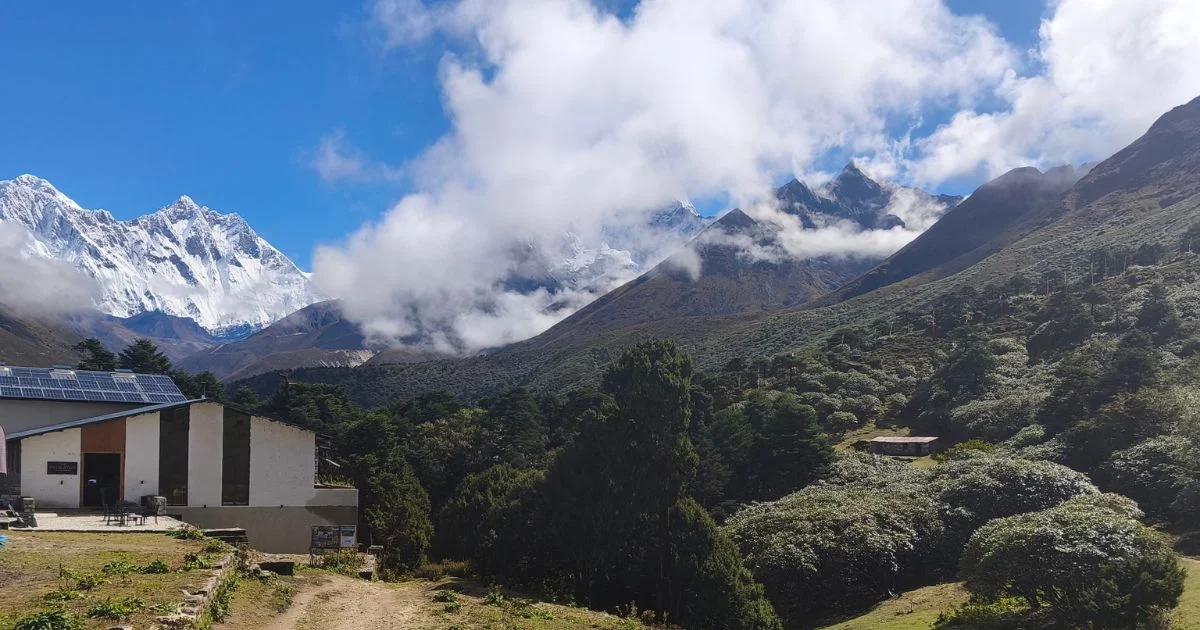
Preparation and Training
Physical preparation for a Cho Oyu expedition demands a comprehensive approach that addresses cardiovascular fitness, strength, and altitude adaptation. While the technical demands may be less severe than other 8,000-metre peaks, the physical requirements remain formidable for any climber attempting this 8000-meter peak.
Essential Training Components:
Cardiovascular conditioning through sustained aerobic activities
Functional strength training focusing on legs, core, and endurance
High-altitude climbing experience above 6,000 metres preferred
Mental preparation and decision-making under stress
Technical mountaineering skills including crampon use and rope work
Moreover, prior high-altitude experience, while not absolutely essential, provides significant advantages. Ideally, climbers should have experience above 6,000 metres and understand their personal responses to altitude. Additionally, training peaks like Aconcagua, Denali, or other major mountains offer valuable preparation opportunities.
Furthermore, acclimatisation planning should begin before arriving at base camp. Consequently, many successful expedition members spend time at moderate altitudes in the weeks leading up to their Cho Oyu expedition, allowing their bodies to begin the adaptation process before encountering the extreme elevations.
Subsequently, mental preparation deserves equal attention to physical conditioning, as the ability to maintain focus and make sound decisions while exhausted can determine expedition success.
Gear and Equipment Checklist
Proper equipment selection can make the difference between success and failure on Cho Oyu. While the technical demands may be less severe than other 8,000-metre peaks, the extreme altitude and harsh conditions require specialized gear designed for the most demanding environments.
Essential Equipment Categories:
Clothing Systems - Layered protection against temperatures below -30°C
Down Suits - Specialized 8,000-metre climbing insulation
Footwear - Double boots with removable inner boots and gaiters
Sleeping Systems - Expedition-weight bags rated to -30°C minimum
Technical Gear - Harnesses, helmets, crampons, and ice axes
Oxygen Systems - Masks, regulators, cylinders with backup systems
Initially, clothing systems must provide protection against temperatures that can drop below -30°C while allowing sufficient ventilation during periods of intense exertion. Therefore, the layering principle becomes crucial, with base layers, insulating layers, and shell protection all serving specific functions.
Additionally, down suits designed for 8,000-metre climbing are essential for summit attempts. These specialized garments provide the insulation necessary to maintain core temperature during extended exposure to extreme cold and wind. Consequently, quality down suits represent a significant investment but are non-negotiable for safety at extreme altitude.
Furthermore, footwear requires careful consideration, as frostbite poses a constant threat above 7,000 metres. Double boots with removable inner boots, combined with high-altitude gaiters, provide the protection necessary for safe climbing. Hence, boot selection should prioritize warmth over weight, as frozen feet can end expeditions prematurely.
Moreover, oxygen systems, while not always mandatory, are used by many climbers on Cho Oyu. Personal oxygen setups include masks, regulators, and cylinders, with backup systems providing crucial redundancy. Understanding oxygen system operation and maintenance is essential for those choosing to climb with supplemental oxygen.
Itinerary Overview
A typical Cho Oyu expedition spans 6-7 weeks, allowing adequate time for acclimatisation, weather delays, and the gradual progression required for safe high-altitude climbing. Furthermore, this timeline includes travel days, rest periods, and contingency time for adverse conditions.
Typical Expedition Timeline:
Week 1 - Arrival in Lhasa, permits, drive to base camp
Weeks 2-3 - Base camp establishment, initial acclimatisation rotations
Weeks 4-5 - High camp rotations, summit preparation
Week 6 - Summit attempts, descent, base camp breakdown
Week 7 - Return journey, departure from Tibet
Initially, the journey begins with arrival in Lhasa, Tibet's capital, where expedition members spend several days completing permit formalities and beginning altitude adaptation at 3,650 metres on the Tibetan plateau. This period allows for final gear checks and gradual physiological adjustment.
Subsequently, travel to base camp typically requires 3-4 days, covering approximately 600 kilometres across the spectacular Tibetan plateau. The drive provides remarkable scenery while allowing continued altitude adaptation as the route gradually climbs toward the mountain.
Meanwhile, base camp establishment and initial reconnaissance occupy the first week at the mountain. Expedition teams organize equipment, establish communication systems, and begin short acclimatisation walks to familiarize themselves with local terrain and conditions around Cho Oyu.
Additionally, the acclimatisation phase follows a carefully planned schedule designed to maximize altitude adaptation while minimizing risk. Initial forays to Advanced Base Camp, followed by progressively higher camps, allow climbers to adapt gradually to the extreme altitude environment.
Finally, summit rotations typically begin after 3-4 weeks at the mountain, when weather conditions and team readiness align. Multiple summit opportunities are planned into expedition schedules, providing flexibility for weather delays or individual readiness issues.
Challenges, Risks and Safety
Despite its reputation as the most accessible 8,000-metre peak, Cho Oyu presents serious risks that demand respect and careful management. Understanding these challenges allows climbers to prepare appropriately and make informed decisions throughout their expeditions.
Primary Risk Categories:
Altitude-related illness - AMS, HAPE, HACE affecting even experienced climbers
Weather hazards - Sudden storms, extreme cold, high winds exceeding 200 km/h
Terrain dangers - Crevasse fields, avalanche zones, exposed ridges
Limited rescue capability - Remote location with restricted helicopter access
Altitude-related illness remains the primary concern for all climbers attempting Cho Oyu. Acute mountain sickness, high-altitude pulmonary edema, and high-altitude cerebral edema can affect even well-acclimatised expedition members.
Weather hazards include sudden storms that can trap climbers in exposed positions, extreme cold that threatens frostbite and hypothermia, and high winds that make movement dangerous or impossible. Cho Oyu's position exposes it to jet stream winds that can exceed 200 kilometres per hour.
Rescue capabilities in the Mount Cho Oyu area are limited compared to more developed mountain regions. While helicopter rescues are possible from lower elevations, climbers above 6,500 metres must often be evacuated on foot to reach helicopter pickup points.
Cost and Budget Breakdown
Climbing Mt. Cho Oyu represents a significant financial investment, with total expedition costs typically ranging from $25,000 to $45,000 per person depending on service levels and group size. Understanding the various cost components helps climbers budget appropriately and avoid unexpected expenses.
Essential Budget Considerations:
Tibet climbing permits cost approximately $2,500 per expedition member
Guided expeditions include Sherpa support, mountain guides, and logistics
Equipment costs vary dramatically based on existing gear ownership
Weather delays can extend expeditions by 1-2 weeks, increasing costs
Emergency evacuation insurance is mandatory but rarely covers full rescue costs
Expedition service costs vary dramatically based on the level of support provided. Basic expeditions to Cho Oyu with minimal services start around $8,000-10,000, while fully guided expeditions with comprehensive logistical support can exceed $25,000 per person.
Success Rates and Records
Cho Oyu enjoys some of the highest summit success rates among the fourteen 8,000-metre peaks, reinforcing its reputation as the most accessible of the world's highest peaks. Historical data shows success rates typically ranging from 60-75% depending on conditions and guided expedition quality.
Notable Cho Oyu Statistics:
Average success rate: 60-75% (highest among 8,000m peaks)
Fatality rate: 1-2% (lowest among major Himalayan peaks)
First-time 8,000m climbers: ~40% of successful summiteers
Female climbers: ~15% of total successful ascents
Seasonal variation: Spring typically 10% higher success than autumn
Initially, Mount Cho Oyu was first attempted by a British expedition in 1952, but the Austrian expedition achieved the first ascent in 1954. Subsequently, the mountain's climbing statistics reflect its appeal to first-time high-altitude climbers, with approximately 40% of successful summiteers attempting their first 8,000-metre peak.
Moreover, weather plays a crucial role in success rates, with spring expeditions generally achieving higher success percentages than autumn attempts. Consequently, years with stable weather patterns often see success rates exceeding 80% for well-prepared expedition teams.
Furthermore, the current speed record stands at under 11 hours from Advanced Base Camp to summit and back, demonstrating the mountain's potential for fast ascents by elite mountaineers. Additionally, age records highlight the mountain's accessibility, with summiteers ranging from 16 to over 70 years old.
Notably, many climbers have successfully summited Cho Oyu via the north-west ridge, and some have used this experience to attempt on Mount Everest the following year. In fact, Mt. Cho Oyu is nangpa la area's most accessible 8,000-metre peak, making it an ideal stepping stone for those seeking to reach the summit of more challenging mountains.
Finally, the sixth highest peak maintains one of the lowest fatality rates among 8,000-metre peaks, typically ranging from 1-2% of summit attempts, with most fatalities resulting from altitude-related illness rather than technical climbing accidents. of the 8,000-metre peaks, typically ranging from 1-2% of summit attempts. Most fatalities result from altitude-related illness, exposure, or falls rather than technical climbing accidents.
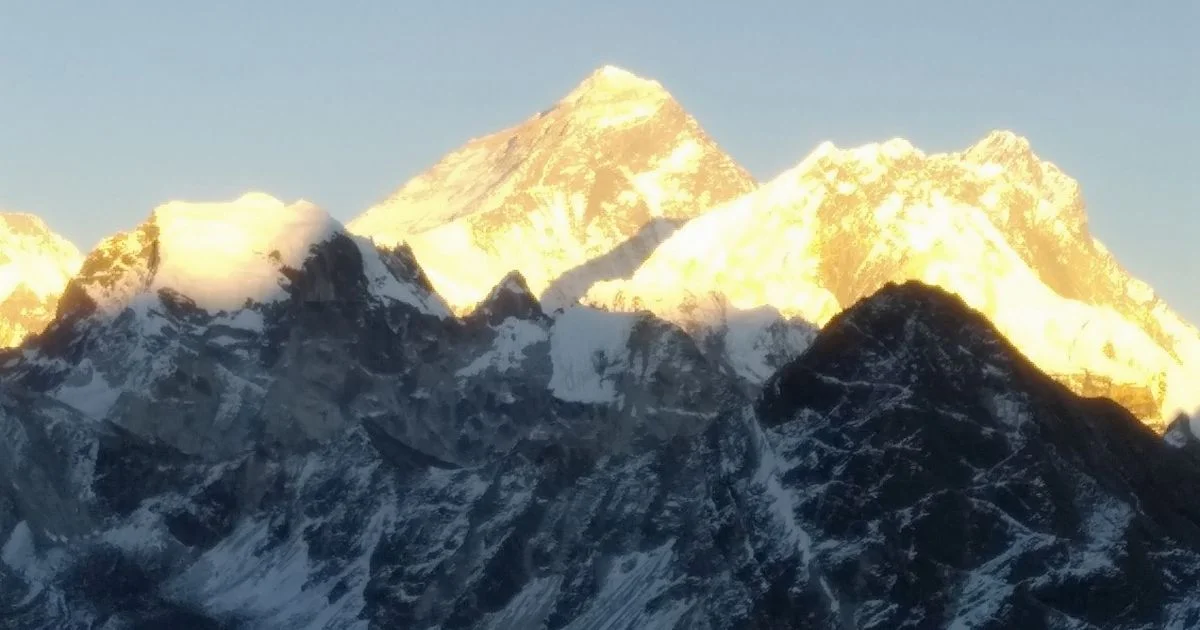
Culture and Environment
The region surrounding Mt. Cho Oyu holds deep cultural significance for both Tibetan and Sherpa communities, who have lived in harmony with these mountains for centuries. Understanding and respecting local cultures enhances the expedition experience while contributing to sustainable tourism practices.
Cultural and Environmental Considerations:
Spiritual Traditions - Tibetan Buddhist practices visible through prayer flags and monasteries
Sacred Mountains - Local communities view peaks as sacred, requiring respectful behaviour
Economic Impact - Expeditions provide crucial income for Sherpas, guides, and porters
Environmental Challenges - Climate change affects glacier stability and route conditions
Conservation Efforts - International organizations work to balance access with protection
Tibetan Buddhist traditions permeate the area, with prayer flags, mani stones, and monasteries marking the spiritual significance of the landscape. Many local people view the mountains as sacred, requiring respectful behavior from visiting climbers who enter these traditionally protected spaces.
Additionally, environmental challenges facing Mount Cho Oyu include climate change impacts on glacier stability, increasing expedition numbers, and waste management issues. Rising temperatures affect route conditions and increase objective hazards, while growing numbers of climbers stress fragile high-altitude ecosystems.
Furthermore, responsible climbing practices include following Leave No Trace principles, supporting local communities through fair employment practices, and minimizing environmental impact through careful waste management. Many expedition companies now implement comprehensive environmental protocols to address these concerns.
Moreover, the economic impact of Cho Oyu expeditions provides crucial income for local communities, supporting guides, porters, yak herders, and service providers. Choosing expedition operators who prioritize fair wages and working conditions helps ensure that climbing tourism benefits local populations, including the Sherpas who contribute significantly to expedition success.
Mount Cho Oyu: The Turquoise Gateway
Mount Cho Oyu offers an exceptional introduction to 8,000-metre climbing, combining the prestige of extreme altitude achievement with manageable technical demands. Its reputation as the most accessible of the world's highest peaks is well-deserved, though this accessibility should never be mistaken for simplicity. The mountain demands respect, proper preparation, and conservative decision-making throughout the expedition.
The mountain rewards careful preparation and respectful approach to local cultures with experiences that few climbers ever forget. Success on Cho Oyu provides not only personal satisfaction but also the experience and confidence needed for more challenging high-altitude objectives. Its proven track record of success, combined with relatively straightforward logistics and moderate technical demands, makes it the logical stepping stone into the rarefied world of 8,000-metre mountaineering.
Ready to begin planning your Cho Oyu expedition? For climbers ready to test themselves against one of the planet's great mountains, Cho Oyu represents an ideal choice. Contact Nepal Everest Base Camp Co. today for expert guidance and support necessary for a safe and successful climb.
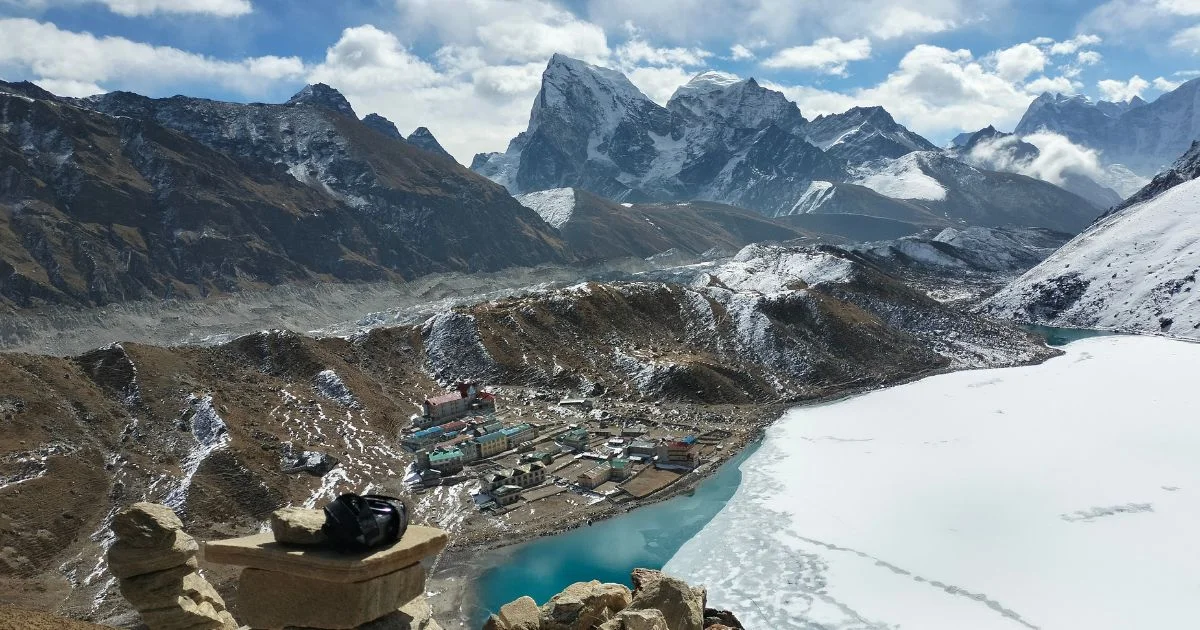
Frequently Asked Questions
Do I need prior 8,000-metre experience to climb Mount Cho Oyu?
Prior 8,000-metre experience is not essential, but extensive high-altitude climbing experience above 6,000 metres is strongly recommended. Most successful first-time 8,000-metre climbers have extensive experience on technical peaks in ranges like the Alps, Andes, or Alaska.
Is supplemental oxygen required for Mount Cho Oyu?
Supplemental oxygen is not mandatory, and many climbers successfully summit without it. However, approximately 70% of summiteers use oxygen systems, particularly above 7,500 metres. The decision depends on individual experience, acclimatisation, and risk tolerance.
Can Mt. Cho Oyu be climbed without a professional guide?
While technically possible for extremely experienced mountaineers, the vast majority of climbers join guided expeditions or organized groups. The logistical complexity, permit requirements, and safety considerations make independent climbing extremely challenging for all but the most experienced climbers.
How long does a complete Mt. Cho Oyu expedition take?
A typical expedition requires 6-7 weeks from arrival in Lhasa to departure. This includes travel time, acclimatisation periods, weather delays, and the actual climb. Some fast expeditions complete the climb in 5 weeks, while others may extend to 8 weeks due to weather or personal factors.
What level of technical climbing skill is required?
Cho Oyu requires solid mountaineering fundamentals including crampon and ice axe use, rope team travel, crevasse rescue techniques, and experience with fixed ropes. Advanced technical rock or ice climbing skills are not necessary, but climbers should be comfortable on moderate snow and ice terrain up to 45-degree slopes. systems, particularly above 7,500 metres. The decision depends on individual experience, acclimatisation, and risk tolerance.
Can Mount Cho Oyu be climbed without a professional guide?
While technically possible for extremely experienced mountaineers, the vast majority of climbers join guided expeditions or organized groups. The logistical complexity, permit requirements, and safety considerations make independent climbing extremely challenging for all but the most experienced climbers.
How long does a complete Mount Cho Oyu expedition take?
A typical expedition requires 6-7 weeks from arrival in Lhasa to departure. This includes travel time, acclimatisation periods, weather delays, and the actual climb. Some fast expeditions complete the climb in 5 weeks, while others may extend to 8 weeks due to weather or personal factors.
What level of technical climbing skill is required?
Mount Cho Oyu requires solid mountaineering fundamentals including crampon and ice axe use, rope team travel, crevasse rescue techniques, and experience with fixed ropes. Advanced technical rock or ice climbing skills are not necessary, but climbers should be comfortable on moderate snow and ice terrain up to 45-degree slopes.





